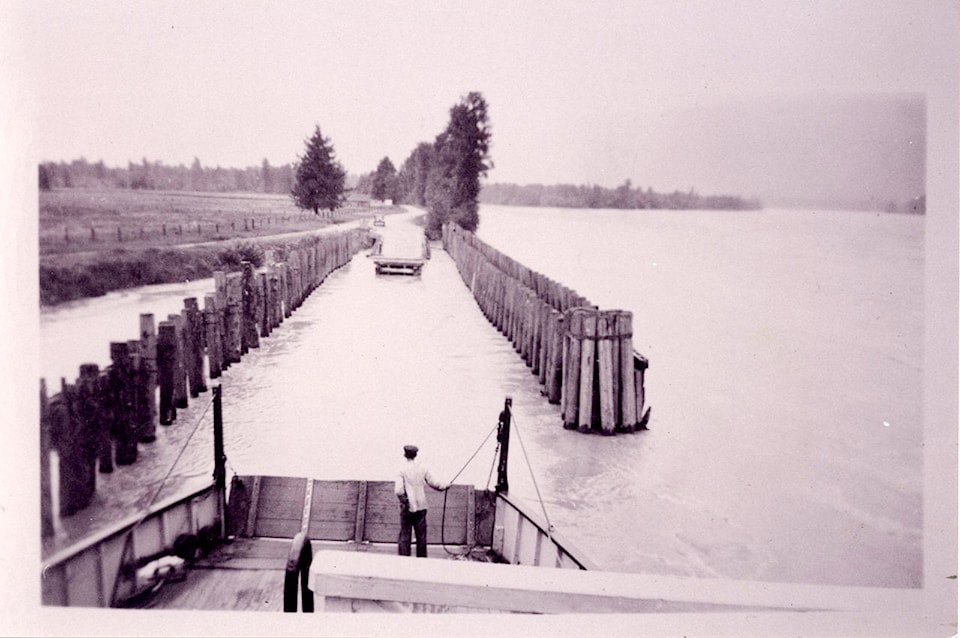By Luke Kelly
The “Ferry Age”, as declared by writer Laura Linton, is a perfect period for romantic reflections. In her Vancouver Sun article in 1955, Linton painted the history of river transportation in Agassiz with swaths of nostalgia and adventure — just as she was staring progress and efficiency square in the face.
River transport across the Fraser was described through limitations the people of Agassiz and the surrounding communities had to endure; in the early 1900s residents crossed the river using “an open scow,” which, if heavily loaded, could become “almost level with the water,” according to early Agassiz settler Harvey Naismith.
| The Agassiz ferry Eena as it travels over the Fraser River. (Agassiz-Harrison Historical Society) |
When this stone and steel umbilical cord was completed in the fall of 1956, the people no longer had to rely on scows, or even the ferry schedule, which saw vehicles move from Agassiz to Rosedale.
What Linton did not anticipate in her article was how vocal community members would become with the arrival of the bridge. It was likely not her goal to cover every angle of the bridge’s creation, but her article was still rooted in thoughts of community impact and of perspective: these were thoughts that residents of Agassiz had in spades even before the bridge was opened.
RELATED: Dozens share in Agassiz history at first-ever Heritage Speaker Night
When the bridge did open, it allowed for opportunities the community of Agassiz had never experienced before. Chilliwack was an exciting alternative to the doldrum and worn experiences of the small isolated river community. The people knew what they wanted, and as a result some changes occurred: the Aga Theater and other businesses around town closed. Local newspapers shared the frank opinions of the community. In 1956, the Chilliwack Progress had headings such as “Threat to business,” a story which detailed how “a few Agassiz merchants saw the bridge as a potential threat,” and “Let’s park the ark,” which was part of the “catchy slogan” the Chilliwack Board of Trade developed for promoting a need for the bridge.
| The Agassiz-Rosedale Bridge as it was under construction in the 1950s. (Agassiz-Harrison Historical Society) |
Although the bridge was a sign of progress in Agassiz, the realities soon became all to apparent. Progress and efficiency took on a different form — perhaps a form that would best be described through cut corners.
The communities which depended on the bridge found their expectations unmatched. The success of the bridge was questioned from the get-go: an article from The Province in 1956 that was published a week before the bridge’s opening reported that residents were a “little bitter that the government, while engaged in the $4,000,000 project (approximately $36.5 million today) didn’t go ‘all out’ and provide a four-lane span that would take care of traffic needs well into the future.”
This scathing remark echoes the community notions of today, 63 years after the bridge was built. It still has two lanes, and is still the main thoroughfare for traffic going to and from Agassiz and the surrounding communities. What has changed is the number of vehicles that use it: from a projected 7,000 per day in 1956 to the current 11,000 per day.
Expanding the bridge to four lanes will take considerable effort. A 1956 article in the Chilliwack Progress summarized the struggles that accompanied the bridge’s development: the subheadings “Back To Starting Point,” “Bond Delayed” and even “Struggle All But Over” describe a telling journey of the efforts to build the bridge.
| The Agassiz-Rosedale Bridge. (Agassiz-Harrison Historical Society) |
These issues continue to plague the bridge today; the promised funding for its expansion has seen setbacks, as noted by MLA Laurie Throness in a 2017 article in the Agassiz Harrison Observer: “Because of the expected increase in cost — Throness didn’t know how much of an increase was anticipated — the project will likely need to return to the legislature for more funding.”
RELATED: Agassiz-Rosedale Bridge construction could start in 2021, MLA says
The bridge span is steady and unmoving as it provides an important connection across the Fraser, but there are unseen issues which are in motion around it.
Underneath it all, the ferry roads and physical echoes of the past can be seen along the banks of the Fraser. One only needs to read a nostalgic article or two as they walk alongside the river to imagine what life was like before the Agassiz-Rosedale Bridge came to town — yet the constant flow of traffic on the bridge above will provide a distraction for those becoming too reminiscent of the past.
Want to read more about the history of the District of Kent for its 125th anniversary? Check out agassizharrisonobserver.com/tag/kent-125/.
news@ahobserver.com
Like us on Facebook and follow us on Twitter
